
Navymen take a break guarding the Likas Island, one of the nine island stations in the West Phil. Sea. INQUIRER/ MARIANNE BERMUDEZ
WEST PHILIPPINE SEA — In between turquoise waters and rich fishing grounds in the Spratly Islands — a major archipelago in the South China Sea — are nine islands and reefs where Filipino troops stand guard.
While their powdery white sands and crystal clear waters could rival Boracay’s or El Nido’s, the maritime features are prized more for their geopolitical importance, making them the subject of a claims dispute among the Philippines, China, Vietnam, Taiwan and Malaysia.
In a weeklong sail in late June, the Inquirer joined the BRP Mangyan (AC-71), a World War II-era Philippine Navy auxiliary ship, for a maritime patrol and to bring fresh troops and supplies to seven of nine military outposts in these disputed areas: Likas (West York), Kota (Loaita), Panata (Lankiam Cay), Parola (Northeast Cay), Pag-asa (Thitu), Patag (Flat) and Lawak (Nanshan).
Each “rotation and resupply” (Rore) is unique, according to BRP Mangyan commanding officer Cmdr. Rommel Marcello Panol. For this trip, the weather and seas were on the side of the Navy — rather unusual in June — except at the tail end where its stay at some islands had to be cut short because of Tropical Depression Caloy.
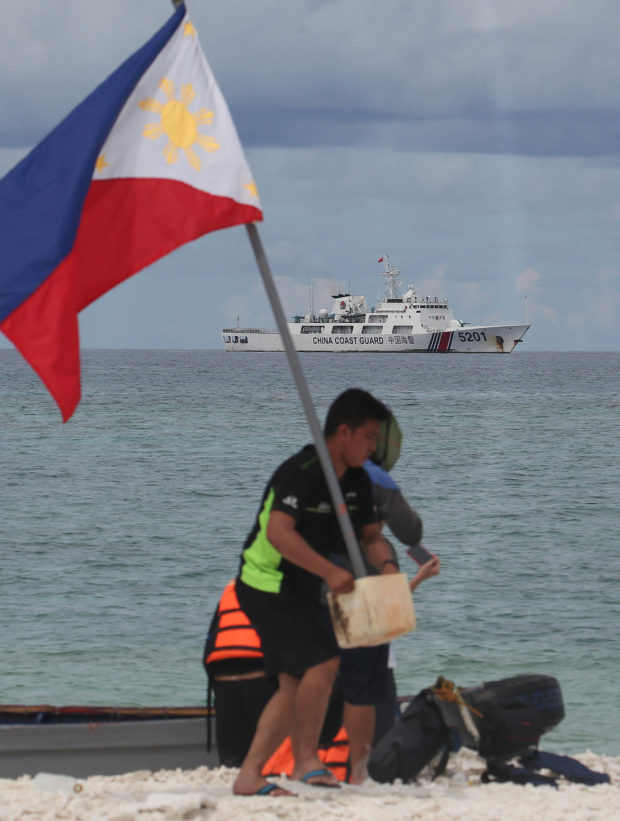
A member of the Phil. Navy carries a Philippine flag during patrol at the Sandy Cay, a sandbar just 4 nautical miles from the disputed Pag-asa island in the West Phil. Sea where a number of Chinese vessels have been spotted. INQUIRER/ MARIANNE BERMUDEZ
Overall, the mission was a success with the journey so different from the one to Ayungin (Second Thomas) Shoal, where sorties have become difficult due to Chinese intimidation. The BRP Mangyan was occasionally tailed by the China Coast Guard and Navy, but most of the time, it was just the Philippine ship and different shades of blue in the horizon, some flying fish and a few local and foreign fishing boats.
Read: Eyewitness at Ayungin: Chinese force, PH grit
Read: China warns PH troops at Ayungin Shoal: Don’t make trouble
“We conduct a Rore once a month to bring food and other provisions. We also ensure that their communication lines are working and drinking water is enough. Those on the islands also inform us ahead of other things they need,” Lt. Jonald Rey Ferrer, the Rore head of mission, told the Inquirer.
“Part of our task is to oversee the troop rotation and to ensure that the provisions are accurately sent to a particular island. Each station has a specific allocation, so we need to make sure that they get the right share so others would not have less,” he said.
The first stop was on remote Likas Island, a 30-hour trip from Puerto Princesa City, located 433 kilometers away. Enclosed by palm trees and scrub grass, it is the second largest island occupied by the Philippines in the Spratlys at 18 hectares.
Here, there is less tension between Filipino troops and the Chinese unlike in Ayungin or Pag-asa, the more strategically important features held by the country. But recently, a China Coast Guard vessel shadowed a Philippine Navy landing ship tank on its way to the island, according to a soldier.
The handful of soldiers and Coast Guard personnel assigned here alternately use generators and solar panels for their power supply. They get clean drinking water from a desalination machine, although the water still tastes different despite the filter, said another soldier.
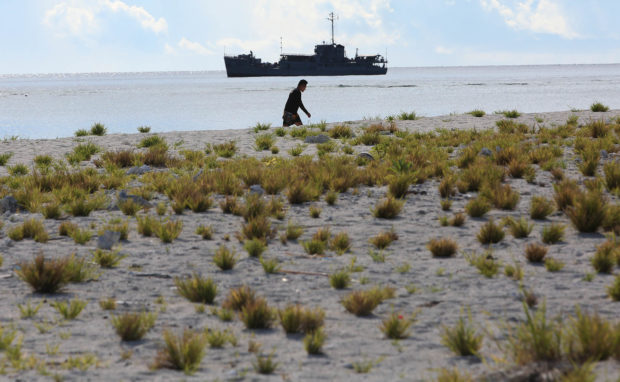
The BRP Mangyan has to anchor at least a kilometer away from shore and rubber boats have to be deployed back and forth to reach the islands during the RORE because of the absence of a pier. INQUIRER/ MARIANNE BERMUDEZ
For entertainment, there is a television set and a concrete pad that serves as a basketball court. The soldiers also keep three dogs. Because there is not much to do, they go fishing or diving with a few passing local and foreign trawlers breaking the monotony.
Their satellite internet helps them fight boredom while also allowing them to communicate with their families, according to a soldier. But the wireless connection at times becomes slow or gets busted.
Likas has basic facilities which underwent recent improvements, although still nowhere near those found in areas occupied by Vietnam and China.
“We have endeavored in continuing facility improvement such as but not limited to the repair of barracks, installation of water desalination plants, and solar panels to sustain the living conditions of our troops. We have also ensured the unimpeded connectivity of our troops to the internet,” said Armed Forces Western Command chief Vice Adm. Alberto Carlos.
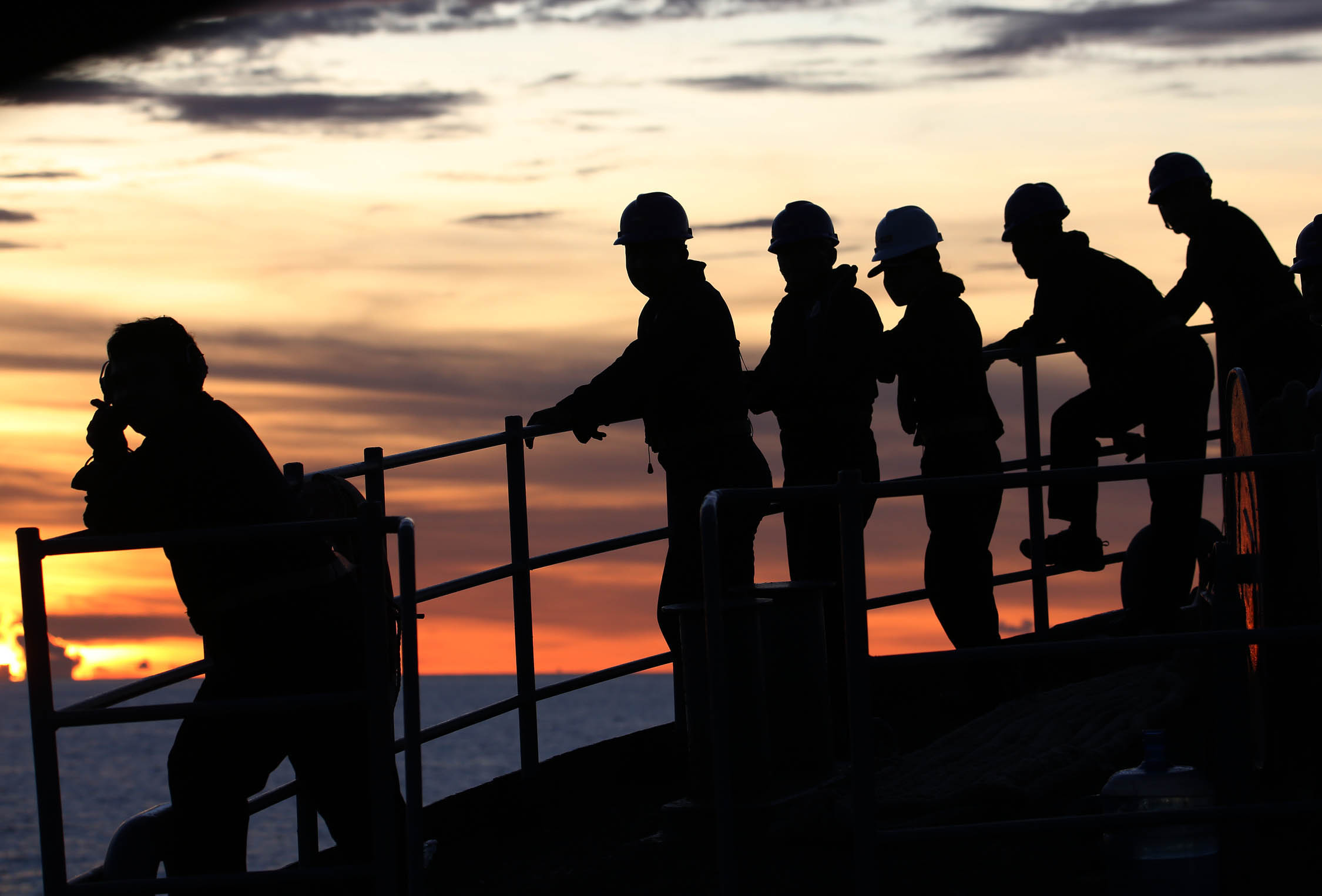
Members of the Philippine Navy watch the sunset from their ship in the West Phil. Sea. INQUIRER/ MARIANNE BERMUDEZ
While each island visited by the BRP Mangyan was different in their own way, the basic facilities and provisions found on each one were almost similar. Even the pastimes of the troops deployed to the islands were nearly identical.
Panata, another stop, is a tiny sandbar that can be explored within a few minutes. It is not as blessed as Likas or its neighbor Kota because there is not enough space to move around. There are no trees, no basketball court and no pets. The soldiers’ barracks are built on stilts.
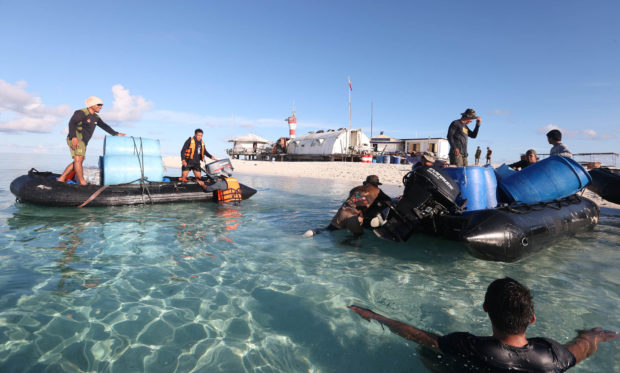
Members of the Phil. Navy load water containers to be refilled at the Panata island which is actually a stretch of sand bar, one of the nine island stations in the West Phil. Sea. INQUIRER/ MARIANNE BERMUDEZ
“We guard this place so other countries will not take it away,” said a soldier. A typical day involves challenging foreign vessels passing through the area “but at times, they just ignore us,” he added.
Their satellite internet, with a connection that could at times become unstable, was important for the troops to entertain themselves. For one soldier, his time online is spent more on watching TikTok videos instead of talking to his loved ones. “If we talk to our wives all day, we will run out of things to talk about. If that happens, they will find things to fight [with us] about,” he said in jest.
There is a desalination machine for drinking water, but they also rely on rainwater. They also had water gallons replenished at the time of the Rore.
Just 2 km away from a Vietnamese-occupied feature called Pugad (Southwest Cay) is Parola. There are different versions on how it was seized by Vietnam from the Philippines in 1975, but both countries have coexisted peacefully ever since. Their troops even get together for games, with each side taking turns playing host on their occupied island.
As far as improvements go, however, Vietnam has done a lot more to modernize Pugad Island which has a harbor, roads, windmills and several buildings.
A Filipino trooper said that while they could not help but feel envious of their Vietnamese friends’ “well-established” facilities, there were also efforts to develop Parola although on a modest scale.
Pag-asa, the largest feature occupied by the Philippines at 37 hectares, has a small civilian population. But the presence of Chinese vessels is almost constant, as Zamora (Subi) Reef is 26 km away. The Inquirer joined a patrol around the sandbars between these islands, witnessing firsthand how the Chinese intimidated Filipinos at sea.
Read: Pag-asa sandbars next WPS flashpoint?
Of the country’s nine military outposts, Pag-asa has seen the most developments and is the only one with a runway and a pier. The refurbishment of a 1.2-km runway first built in the 1970s is already nearing completion.
New facilities are being constructed here to support the civilians and troops, while several structures destroyed by Typhoon “Odette” last December still need to be repaired. It is also the only island with a cellular network.
The government plans to turn Pag-asa into a military logistics hub and build a gas depot so that fishermen will not have to refuel in the mainland located 400 km away.
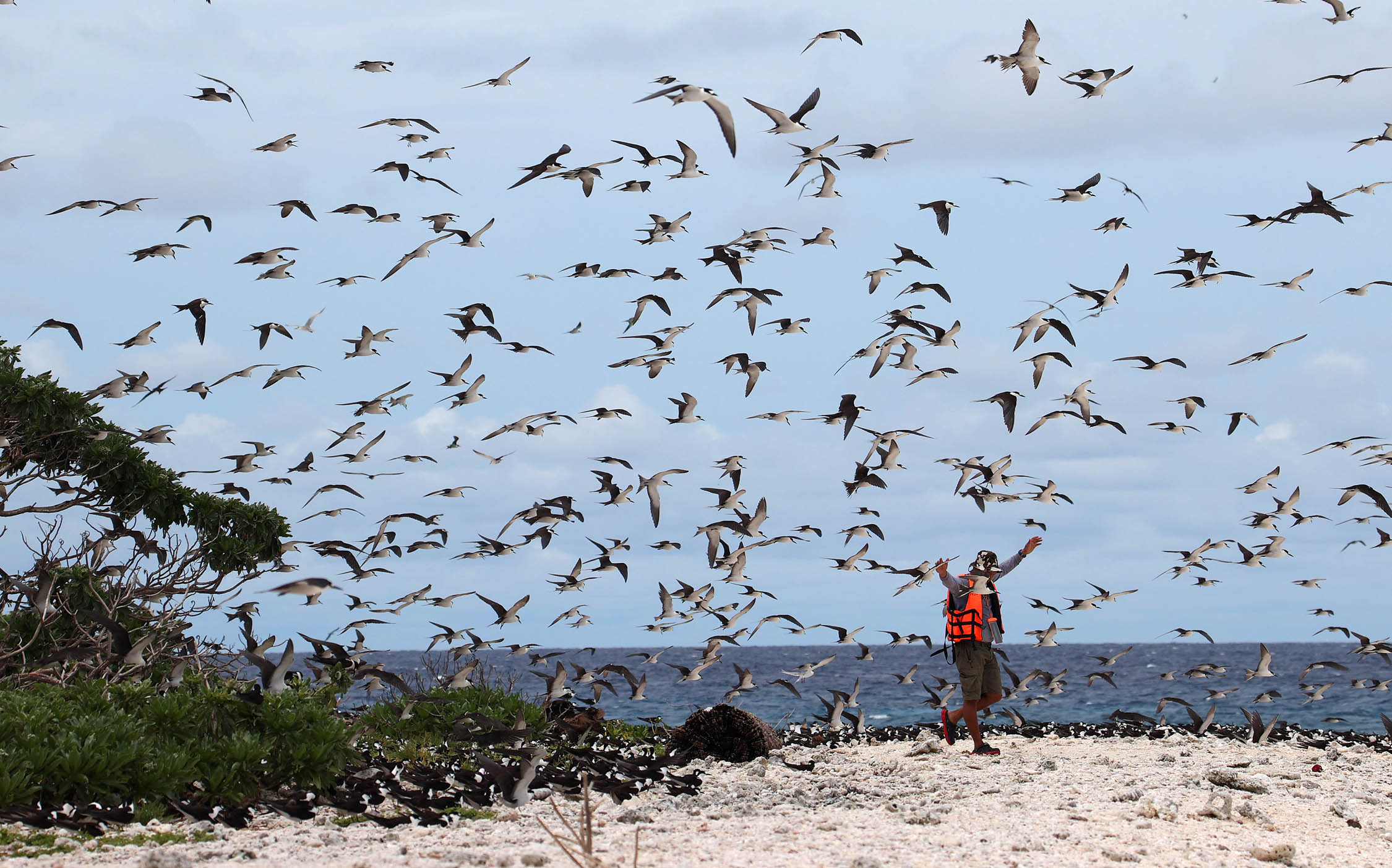
A Phil. Navyman walks through a seagull covered beach at the Lawak island (Nanshan island) ,the 8th of the largest natural island of the disputed Spratly islands located 98 miles from Pag-asa island and is also a bird sanctuary. President elect Bongbong Marcos has recently agreed to uphold the Hague ruling on the West Phil Sea, affirming the country’s claim on the disputed waters. INQUIRER/ MARIANNE BERMUDEZ
The last stop in the journey, Lawak Island, was a picturesque deserted island paradise and a seagull sanctuary. It was hard to hear each other over the squawking of the birds who had laid eggs on grassy paths. The barracks for soldiers on the other side of the island were modest. Like their counterparts in other outposts, they were battling isolation and boredom.
“Sometimes, we get visitors. There are fishermen from the mainland stopping by,” said a soldier. “But that’s it.”
The military is still far away from its goal of building up a strong armed force that would match the fortitude of its troops assigned to the disputed islands. Except for Ayungin which was occupied only in 1999, few improvements have been done on military outposts since these were occupied during the time of President Ferdinand Marcos in the 1970s. Ironically, the Philippines was the first among claimant countries to build an airstrip in the Spratlys.
Except for Pag-asa, the islands visited by the BRP Mangyan have no pier. The ship had to anchor at least a kilometer away from shore and rubber boats had to be deployed back and forth to reach the islands, making the transfer of troops and supplies more difficult.
“Ideally, there should be a sheltered port on every island. But there are no funds for that yet,” Carlos said.
There are also not enough sea assets to patrol the vast waters of the Kalayaan Island Group that stretch 443486.587 square kilometers.
The 78-year-old BRP Mangyan was supposed to be retired in December, but officials deemed it could hold on a bit longer. It was first commissioned by the United States Army as a supply ship in 1944. It was then transferred to the Japan Maritime Self-Defense Force as JDS Miho in 1955 to conduct minesweeping missions until 1974 before becoming part of the Philippine Navy in 1979.
The ships recently bought by the government from South Korea’s Hyundai Heavy Industries—two corvettes and six offshore patrol vessels—will only see the first deliveries in two to three years at the earliest.
Philippine troops stationed in seven outposts in the Spratly Islands receive provisions from the Philippine Navy during a resupply mission in late June. (Photos by MARIANNE BERMUDEZ / Philippine Daily Inquirer) INQUIRER/ MARIANNE BERMUDEZ
In the meantime, the country’s neighbors continue to strengthen their stakes in the Spratlys, the Washington-based think tank Asia Maritime Transparency Initiative (Amti) said in a recent report.
Taiwan has carried out “minor land reclamation” on the western end of Itu Aba, its only occupied feature in the Spratlys, Amti said.
China has also completed several structures and minor construction work on Mabini (Johnson) Reef. On Panganiban (Mischief) Reef, a few new radomes were seen earlier this year.
Amti also observed “large blue-roofed structures, likely temporary given the speed at which they have been erected and in some cases moved from one location to another,” on all of the seven military bases occupied by China in the Spratlys from 2019 to 2021.
The report likewise included the progress on Pag-asa’s runway, as well as the minor construction on other islands held by the Philippines.
Earlier this year, Amti reported that Vietnam had carried out new dredging and landfill at three of its occupied features in the Spratlys, as well as minor upgrades on several bases.